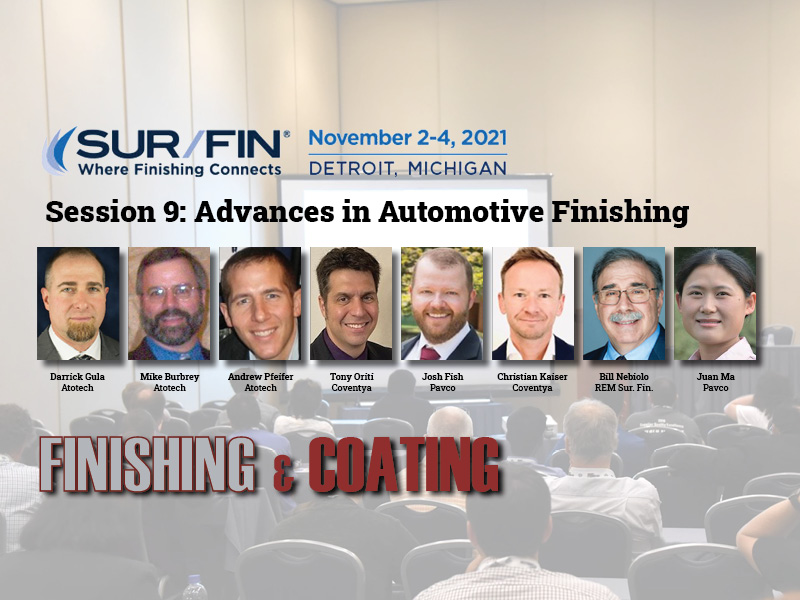Session 9 at SUR/FIN is called “Advances in Automotive Finishing,” and features nine presentations starting Nov. 4 at 8:30 a.m.
Caleb Morrison from Atotech and Dr. Ling Hao from Lacks Enterprises are the session chairs.
Here is a look at the presentations:
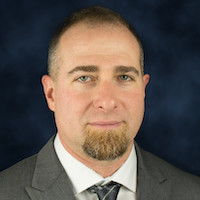 Darrick Gula8:30 a.m. - 9:00 a.m.: Expanding Fashion Finishes in Decorative Plating for Automotive Applications; Darrick Gula, North America Automotive OEM Manager at Atotech USA
Darrick Gula8:30 a.m. - 9:00 a.m.: Expanding Fashion Finishes in Decorative Plating for Automotive Applications; Darrick Gula, North America Automotive OEM Manager at Atotech USA
Decorative plating applications continue to be, by in large, bright Nickel-Chromium finishes. However, changing styling cues are shifting away from the standard finish. New designs in the Electric vehicles continue to change current styling trends. Innovations in new finishes will be the key to our future. With the introduction of Satin Nickel in the 1960’s new design opportunities were created. Today, Satin can be found across many industries including automotive, sanitary, home hardware and general goods. Satin continues to grow in popularity due to its breadth of appearance from light to medium to heavy satin effects. Trichrome as a replacement for Hexavalent chromium was introduced in the 1920s but it was not until the early 2000’s that it began to show up consistently in the market. Now with Trivalent deposits achieving colors near that of Hex Chrome, or conversely colored trichrome producing varying degrees of dark deposits, Trichrome is finding more and more interest as a fashion finish. Lastly, the market is seeing an increased interest in Paint Over Chrome (POC) which allows for clear to solid coatings to be applied to Chrome plated parts. These coatings are available in a wide selection of colors. Combining all three of these technologies allows the customer, plater, and end user endless possibilities.
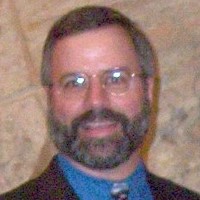 Mike Burbey9:00 a.m. - 9:30 a.m.: Combining Coating Layers to Meet the Changing Demands for the Automotive Industry; Mike Burbey, Integration Manager, North America at Atotech USA and Andrew Pfeifer, Business Manager, Corrosion Protection North America at Atotech USA
Mike Burbey9:00 a.m. - 9:30 a.m.: Combining Coating Layers to Meet the Changing Demands for the Automotive Industry; Mike Burbey, Integration Manager, North America at Atotech USA and Andrew Pfeifer, Business Manager, Corrosion Protection North America at Atotech USA
Extended design life of vehicles has drastically increased the corrosion protection requirements in the automotive industry. Changes in adjacent part design, the variety of weather (within the midwest) and exposure to sodium/calcium chloride (road de-icers) create a challenging set of circumstances for OEMs to meet these requirements. In addition to increased durability, there is a trend to use more styled finishes on a variety of parts. OEM’s are exploring the opportunity to provide high-end solutions on production components.
 Mark Schario9:30 a.m. - 10:00 a.m.: Decorative Plating: Examining the Cost and Performance Drivers Behind the Switch from Hexavalent to Trivalent and Exploring the New Trivalent Electrolyte with Reclaim Capabilities; Mark Schario, Executive Vice President at Columbia Chemical.
Mark Schario9:30 a.m. - 10:00 a.m.: Decorative Plating: Examining the Cost and Performance Drivers Behind the Switch from Hexavalent to Trivalent and Exploring the New Trivalent Electrolyte with Reclaim Capabilities; Mark Schario, Executive Vice President at Columbia Chemical.
As the industry begins to reach a tipping point on the need to switch from decorative hexavalent chromium plating to trivalent chromium, the operational cost of the switchover along with the finished appearance and performance have become the primary drivers in decision-making. This presentation will provide an in-depth analysis of the cost of switching and examine the performance and finished appearance of decorative hexavalent chromium compared to traditional trivalent. Important to both applicators and OEMs, we will also explore and compare the new trivalent electrolyte with reclaim capabilities and examine data on cost savings, process considerations and finished appearance.
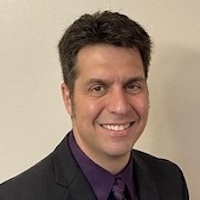 Tony Oriti10:00 a.m. - 10:30 a.m.: Improving the Performance of a Zinc Nickel Plating Operation; Tony Oriti, Senior R&D Chemist at Coventya
Tony Oriti10:00 a.m. - 10:30 a.m.: Improving the Performance of a Zinc Nickel Plating Operation; Tony Oriti, Senior R&D Chemist at Coventya
Over the course of the last two decades, gamma phase zinc-nickel has become a universally accepted protective finish. It is known for its superior corrosion resistance, ability to accept many trivalent and hexavalent finishes and relatively seamless transition into existing conventional zinc lines. Through its increased utilization in the finishing market, much has been learned about the practical application of a zinc-nickel deposit, and we wish to disclose some of this information in this session. Of importance in this discussion will be anoding and racking practices, solution maintenance, membrane technologies, troubleshooting and proper system utilization.
 Josh Fish10:30 a.m. - 11:00 a.m.: Synergistic Effects of Passivates and Topcoats over Zinc and Zinc/Nickel Alloys; Josh Fish, Technical Service/Lab Operations Director at PAVCO
Josh Fish10:30 a.m. - 11:00 a.m.: Synergistic Effects of Passivates and Topcoats over Zinc and Zinc/Nickel Alloys; Josh Fish, Technical Service/Lab Operations Director at PAVCO
For years people have been improving the corrosion resistance of steel by applying zinc plating with hexavalent chromium chromates. Although, as industries continually pushing the limits on salt spray performance, coupled with government pressure to remove hexavalent chromium from plating processes, it has become imperative for post-treatment of zinc and zinc/nickel coatings with passivates and topcoats. This presentation will explore the relationship between the plating, passivate, and topcoat layers and how they improve part performance. It will also discuss new trends in relation to making products less hazardous (i.e. cobalt-free).
 Andrew Pfeifer11:00 a.m. - 11:30 a.m.: Extending Passivate lIfe; Andrew Pfeifer, Business Manager, Corrosion Protection North America at Atotech USA
Andrew Pfeifer11:00 a.m. - 11:30 a.m.: Extending Passivate lIfe; Andrew Pfeifer, Business Manager, Corrosion Protection North America at Atotech USA
Process control of passivates for Zinc & Zinc Nickel plating has a fundamental influence on achieving corrosion protection. Passivation parameters, such as concentration, temperature, time and pH have a strong influence on the formation of the passivate layer. In addition to these parameters, impurities in passivate baths impact corrosion protection, throughput and cost. This presentation will review the effectiveness of various methods of removing iron and zinc from passivate solutions, and outline the overall impact to plating operations. The safest & most effective means of eliminating contamination from passivates is to utilize automated equipment. The result is the ability to use a higher-quality passivate in a steady state operation (minimal downtime) at a significantly lower cost.
 Christian Kaiser11:30 a.m. - 12:00 p.m.: Automotive Fastener Lubrication: Current Challenges and Solutions; Christian Kaiser, MD Microgleit GmbH, Coventya
Christian Kaiser11:30 a.m. - 12:00 p.m.: Automotive Fastener Lubrication: Current Challenges and Solutions; Christian Kaiser, MD Microgleit GmbH, Coventya
Disruptive evolution in automotive technology raise a multitude of new challenges with functional fastening solutions. New materials, designs and requirements call for tailored solutions. Particularly lightweight metals fundamentally differ in their frictional properties compared with traditional materials. New assembly technologies and additional requirements such as thermal loosening or electrical conductivity raise the bar for fastening technologies. Another area of application is thread forming alternatives to classical metric bolts that need good lubricity for several reasons. This presentation will provide an overview of current challenges and solutions taking into account environmental concerns
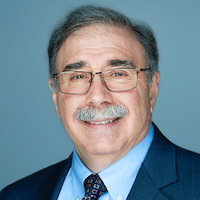 Bill Nebiolo11:30 a.m. - 12:00 p.m.: The Basics of Automotive Surface Engineering by Isotropic Superfinishing; Bill Nebiolo, REM Surface Engineering
Bill Nebiolo11:30 a.m. - 12:00 p.m.: The Basics of Automotive Surface Engineering by Isotropic Superfinishing; Bill Nebiolo, REM Surface Engineering
Certain machined, engineered components are functionally operative because they interact with their complementary partners to transmit energy/motion. Examples of engineered items that transmit energy/motion are bearings or gears. These engineered items transmit energy/motion by rolling, sliding, rotating or engaging their complementary partners. As a function of their operational efficiency the metal-to-metal contact location of the complementary partners becomes an area of great engineering concern, since this contact point is a probable area of parasitic frictional resistance. As such, the finish of the metal-to-metal contact areas becomes a critical variable in the efficiency equation related to energy or motion transfer. Typically machined parts that have been subsequently polished to improve their final surface finish will have under magnification a unidirectional surface pattern that corresponds to the direction of polishing. Although the resulting polished surface is improved versus its original machined condition, the presence of the polishing line asperities minimizes metal-to-metal contact between complementary components because component contact is actually asperity peak-to-asperity peak. Vibratory bowls are commonly used in metal finishing for generic deburring. By utilizing non-abrasive, high density media in conjunction with an isotropic superfinishing (i.e. ISF) chemistry the surfaces of the complementary components can be superfinished to an isotropic or random finish. This improved surface increases energy/motion transfer efficiency in the metal-to-metal contact area by reducing friction and providing an additional number of engineering advantages. This paper will review the technique used to generate the improved isotropic surface finish and will additionally review some of the engineering advantages that can be imparted to metal-to-metal contact surfaces.

Electroplated bolts have been widely used in the automotive industry for many decades. In the present work the effects of each layer of the bolt coating (i.e., electroplating, passivate and topcoat layer) on the torque tension relationship of a bolted joint are experimentally investigated. The K factor is measured by a torque-tension testing system and compared among different experimental conditions. The surface microstructure of each layer is also studied by scanning electron microscopy (SEM) to better understand the mechanisms involved in this work.
To learn more about SUR/FIN, please visit https://www.nasfsurfin.com





